Abstract
In this paper we provide a description of the three-dimensional flow induced by a sequence of lateral obstacles in a straight shallow open-channel flow with flat bathymetry. The obstacles are modelled as rectangular blocks and are located at one channel wall, perpendicular to the main stream direction. Two aspect ratios of the resulting dead zones are analysed. The flow structure is experimentally characterised by particle image velocimetry measurements in a laboratory flume and simulated using three-dimensional Large Eddy Simulations. Good agreement between experimental measurements and numerical results is obtained. The results show that the effect of the obstacles in the main channel is observed up to one obstacle length in the spanwise direction. The spacing between obstacles does not seem to have a large influence in the outer flow. The mean flow within the dead zone is characterised by a large recirculation region and several additional vortex systems. They are discussed in the paper, as well as the mean and root-mean-square wall shear-stresses.




















Similar content being viewed by others
References
Abad JD, Rhoads BL, Guneralp I, Garcia MH (2008) Flow structure at different stages in a meander-bend with bendway weirs. J Hydraul Eng 134(8):1052–1063
Breuer M, Rodi W (1996) large eddy simulation of complex turbulent flows of practical interest. In: Hirschel E (ed) Flow simulation with high performance computers II, notes on numerical fluid mechanics, vol 52. Vieweg, Braunschweig, pp 258–274
Brevis W (2009) Experimental investigation of the flow hydrodynamics in open-channel dead zones. PhD thesis, Faculty of Physical and Mathematical Sciences, University of Chile
Brevis W, García-Villalba M (2011) Shallow-flow visualization analysis by proper orthogonal decomposition. J Hydraul Res 49(5):586–594
Brevis W, Niño Y, Jirka G (2010) Integrating cross-correlation and relaxation algorithms for particle tracking velocimetry. Exp Fluids 50(1):135–147
Constantinescu G, Sukhodolov A, McCoy A (2009) Mass exchange in a shallow channel flow with a series of groynes: les study and comparison with laboratory and field experiments. Environ Fluid Mech 9(6):587–615
García-Villalba M, Fröhlich J, Rodi W (2006) Identification and analysis of coherent structures in the near field of a turbulent unconfined annular swirling jet using large eddy simulation. Phys Fluids 18(055):103
García-Villalba M, Li N, Rodi W, Leschziner MA (2009) large eddy simulation of separated flow over a three-dimensional axisymmetric hill. J Fluid Mech 627:55–96
Germano M, Piomelli U, Moin P, Cabot W (1991) A dynamic subgrid-scale eddy viscosity model. Phys Fluids 3:1760–1765
Hankin B, Holland M, Beven K, Carling P (2002) Computational fluid dynamics modelling of flow and energy fluxes for a natural fluvial dead zone. J Hydraul Res 40:389–400
Hinterberger C (2004) Dreidimensionale und tiefengemittelte large-eddy-simulation von Flachwasserströmungen. PhD thesis, University of Karlsruhe
Hinterberger C, Fröhlich J, Rodi W (2007) Three-dimensional and depth-averaged large-eddy simulations of some shallow water flows. J Hydraul Eng 133:857
Jacoub G, Westrich B (2006) Effect of river groyne structures on flow, sedimentation and erosion dynamics in rivers (Case study: the River Elbe). Geophys Res Abstr 8(06):315
Karami H, Basser H, Ardeshir A (2012) Verification of numerical study of scour around spur dikes using experimental data. Water Environ J
Kirkgöz M, Ardiclioglu M (1997) Velocity profiles of developing and developed open channel flow. J Hydraul Eng 123:1099
Lilly D (1992) A proposed modification of the Germano subgrid-scale closure method. Phys Fluids 4:633–635
McCoy A, Constantinescu G, ASCE M, Weber L (2008) Numerical Investigation of Flow Hydrodynamics in a Channel with a Series of Groynes. J Hydraul Eng 134:157
Nezu I, Rodi W (1985) Experimental study on secondary currents in open channel flow. In: Proceedings of 21st IAHR Congress, vol 2
Palau-Salvador G, García-Villalba M, Rodi W (2011) Scalar transport from point sources in the flow around a finite-height cylinder. Environ Fluid Mech 11(6):611–625
Scarano F (2002) Iterative image deformation methods in piv. Meas Sci Technol 13:R1
Schiemer F, Hein T (2007) The ecological significance of hydraulic retention zones. Hydroecol Ecohydrol 14:405–420
Sukhodolov A, Uijttewaal W, Engelhardt C (2002) On the correspondence between morphological and hydrodynamical patterns of groyne fields. Earth Surf Process Landf 27(3):289–305
Sukhodolov A, Engelhardt C, Krüger A, Bungartz H (2004) Case study: turbulent flow and sediment distributions in a groyne field. J Hydraul Eng 130:1
Ten Brinke W, Schulze FH, van Der Veer P (2004) Sand exchange between groynefield beaches and the navigation channel of the Dutch Rhine: the impact of navigation versus river flow. River Res Appl 20(8):899–928
Tritthart M, Liedermann M, Habersack H (2009) Modelling spatiotemporal flow characteristics in groyne fields. River Res Appl 25(1):62–81
Uijttewaa W, Lehmann D, Mazijk A (2001) Exchange process between a river and its groyne fields: model experimets. J Hydraul Eng 127:928–936
Weitbrecht V (2004) Influence of dead-water zones on dispersive mass transport in rivers. PhD thesis, University of Karlsruhe, Institut for Hydrodynamics
Weitbrecht V, Socolofsky S, ASCE M, Jirka G, ASCE F (2008a) Experiments on mass exchange between groin fields and main stream in rivers. J Hydraul Eng 134:173
Weitbrecht V, Socolofsky SA, Jirka GH (2008b) Experiments on mass exchange between groin fields and main stream in rivers. J Hydraul Eng 134(2):173–183
Westerweel J, Scarano F (2005) Universal outlier detection for piv data. Exp Fluids 39(6):1096–1100
Author information
Authors and Affiliations
Corresponding author
Rights and permissions
About this article
Cite this article
Brevis, W., García-Villalba, M. & Niño, Y. Experimental and large eddy simulation study of the flow developed by a sequence of lateral obstacles. Environ Fluid Mech 14, 873–893 (2014). https://doi.org/10.1007/s10652-013-9328-x
Received:
Accepted:
Published:
Issue Date:
DOI: https://doi.org/10.1007/s10652-013-9328-x




